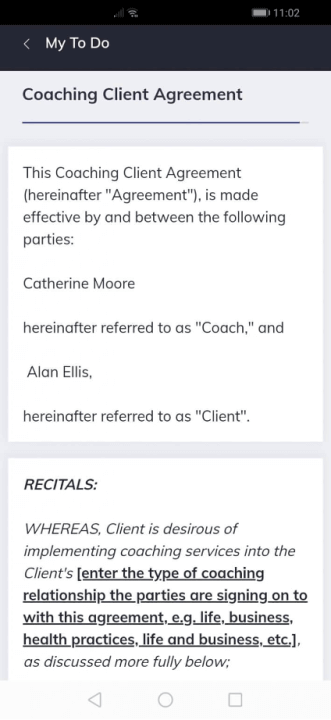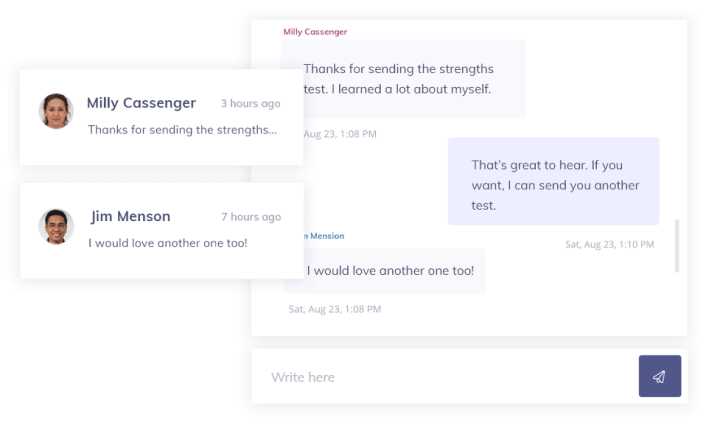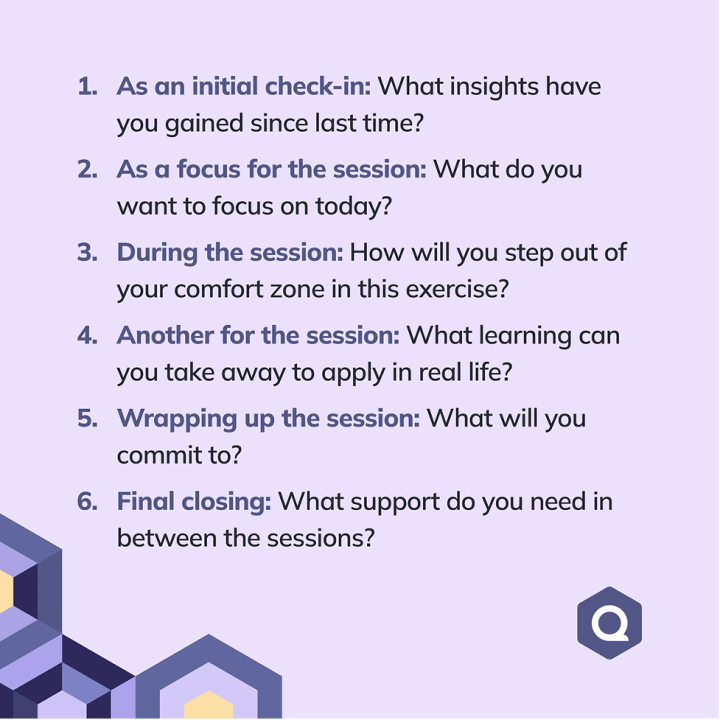“There is no human deed or thought that lies fully outside the experience of other people.” Renowned psychiatrist Irvin Yalom doesn’t just explain process group therapy in his books, he gives real and practical examples of how successful it can be because of the group’s connections.
As Yalom continues to explain in his book on group psychotherapy [1], therapeutic change is a complex process. Nevertheless, group work has proven itself successful across various age groups and mental needs for several decades. Moreover, it’s more cost-effective than individual therapy.
Today, we have the added layer of online group therapy. The overall concept is the same in the sense that the therapist leverages the wisdom of the group to enable personal change. Nevertheless, there are slightly different pros and cons that we’ll discuss, alongside how Quenza can help you as a practitioner.
Understanding Process Group Therapy
The American Psychological Association supports process group therapy as being equally effective as individual therapy, if not more. One of the main reasons the APA gives for this effectiveness is that people feel connected with others. Through this inclusion, much of that stigma that goes with therapy often disappears [2].
So, what is process group therapy? It’s when a group of individuals comes together and are guided by one or two therapists or counselors to relieve mental health symptoms by enabling personal change.
The ground rules are the same for process group therapy as they are for individual therapy. So, confidentiality and contracting are equally important. In fact, the cohesiveness of the group is a core factor of the therapeutic change and group therapists have to carefully create the conditions for psychological safety.So, just like a coach will ensure to have a coaching agreement in place, a group therapist will also have a similar document. Similarly, during the sessions, they’ll ensure everyone is aligned with the overall goal, as well as the goal for that session.
Crafting a Coaching Agreement with Quenza

Thanks to Quenza’s easy-to-use software, you can amend or create your own client contracts and even set them up for sending through mobile phones, as per the image above.
One of the greatest benefits of group therapy is the shift that occurs in a client because of the members around them. While these members act as a support mechanism, the group can also trigger issues that might never appear in a one-on-one relationship.
For example, in many cases, group therapy starts mirroring family dynamics such that clients start reenacting the roles and unhealthy coping mechanisms they developed during their earlier years. With the support of the group, those roles and behaviors can be explored and challenged in order to heal and create new ways of being [1].
The drawbacks are very much tied to the therapist’s skillset and approach. There are many models, frameworks and theories to apply but the art lies in managing the various needs and issues of each member. When therapists get this wrong, people experience confusion, resentment and loneliness.
Nevertheless, it is always good practice for therapists to do a “group readiness check”, through a questionnaire for example, as we’ll discuss later. Some people such as those who are extremely shy, impulsive or highly vulnerable to feedback might also not fare so well in groups [3].
What Topics to Expect in Group Therapy
Process group therapy isn’t a 12-step program or a support group but there are elements of those groups that come into it. Group therapists simply leverage the support mechanism to give people increased awareness of themselves while learning new ways to interact with others.
As such, typical topics range from improving relationships and general family issues to emotional health, including anxiety, stress and depression. Within those topics, some people might simply need to express themselves while others specifically want to learn new skills.
The main goal behind all process group topics is self-exploration along with self-disclosure, as appropriate. Although, self-disclosure is often mixed with the fear of judgment as well as of reliving traumatic moments. So, group work must include a new way of experiencing the situation to avoid falling into fixed views and behaviors. As new emotions form in the here and now, people can gradually let go of their pain.
A psychology professor at Rhodes University, Dr. Zelda Knight, goes through a case study that highlights this well [4]. In her paper, she describes how William, Julia, Ellen and Thomas are all holding onto painful memories. They struggle with the associated emotions of guilt and abandonment, according to their individual stories.
Throughout the case study, you see how the group provides each of them with “unconditional acceptance” and acts as an “alchemical vessel” to provide “corrective emotional experience”. Moreover, as they listen to each other’s stories, they realize that they are experiencing similar negative emotions. Through this normalizing, problems feel more surmountable.
Knowing Your Emotions

Within this space of empathy and warmth, individuals deepen their self-awareness such that they can process their inner conflicts. For instance, in the same case study, Julia talks about noticing the tension in her body when she talks about her experience. Simply noticing it was the first step towards eventually letting it go.
Moreover, by opening up and sharing their inner truths, group members feel a sense of freedom. The realization that self-disclosure fears were not as real as they thought also opens up the idea that the world is perhaps not as frightening or bad. Consequently, individuals form new meanings and they can interact with the world in their refreshed, unique ways.
The Structure of Process Group Therapy
There are two ways of looking at process group structure. First, as a simple process and secondly, as an evolution of group dynamics.
In the first instance, the structure of process group therapy is like any other group setting. So, it starts with an opening, followed by the session and a final closing. Before the sessions start, therapists also do their preparation work which often includes a 1 on 1 session with all the individuals. The aim of those sessions is to gauge their needs, styles and specific issues. This helps the therapist facilitate a discussion where no one takes over or is left in a corner [5].
When looking at topics, as mentioned, these could include any emotional wellness subject such as conflict resolution, self-esteem and setting boundaries. The key with group therapy though is that the therapist doesn’t define the topic. Instead, they prepare how they will guide this particular group of people to determine their own topics and goals together.
Just like a team goes through different stages of development, so does a group in therapy. So, the first meeting and first few formative sessions usually come with heavy anxiety or fear of self-disclosure. At this stage, the therapist’s role is to create a safe space for everyone to start getting comfortable with each other.
A therapist might also explore the benefits of group therapy along with possible concerns. For example, many people still assume it’s a second rate way of getting therapy, despite the APA proving otherwise. So, during this time, the therapist watches how everyone starts establishing their place and their first connections within the group.
Positive Qualities

Again at the beginning, everyone looks to the therapist to set the pace and the tone but with cautiousness. As they ease into the process, the “storming” phase starts, just like for any team in a work environment. At this point, conflict arises and even potentially, some power struggles [1].
All these changes in dynamics, along with the surfacing of difficult emotions, are also part of the work. A great therapist will use these moments to build self-awareness and solidarity with the group. That’s when people start questioning their current approaches and experimenting with new behaviors.
Of course, therapists need to adjust the pace of discussion and type of exercises according to the style of the group. So, some might prefer free-flowing discussions and some might need more structured exercises.
Most importantly, every process group therapy session needs a proper concluding section at the end along with an opportunity for participants to give their feedback. Finally, logistics are confirmed such as whether this is a weekly, bi-weekly or even monthly format.
Session Feedback Form

Typical Process Group Activities
Studies show that process group therapy is as effective as individual therapy, with some even suggesting it is more effective. The process of normalizing human experience within the safe space created by a group is a powerful one. Although, it does take a skilled therapist to get the right balance of discussion versus activities [6].
So, process group topics can even go into sensitive areas such as eating disorders and schizophrenia. Essentially, people who suffer from those disorders benefit from the sense of belonging, hope and altruism that occurs in a group, including forgiveness of self and others [6].
As such, the most powerful group activities are the ones that can engender those feelings, along with compassion as the foundation.
Visualizing a Compassionate Self

What truly differentiates process group therapy is the concept of the “here and now”. This term was coined around the 1940s by Fritz Perls when Perls was working on developing gestalt therapy as inspired by Jacob L. Moreno’s 1920s work. As you can imagine, it refers to being with the felt experience of the now, without shadowing it with justifications or judgements.
The power of the “here and now” is that regardless of when events might have taken place, group individuals experience them with today’s feelings and sensations. By experiencing the past in the present, a certain cleansing and natural reframing occur. So, rather than getting lost in stories about past events, clients process their feelings and emotions more healthily [7].
In light of this, group activities often revolve around visualization, mindfulness and metaphors, all of which encourage people to process emotions in the present [5].
The Metaphor of the Two Arrows

An example of an ancient metaphor from one of Buddha’s stories. With the image of an arrow, Buddha explains that if we are hit by an arrow in battle, we feel pain. How we then react to the arrow deepens our pain and creates more suffering. It’s as if we’d been hit by a second arrow. As such, the exercise guides people to explore how they create second arrows in their lives.
How to Run Process Group Therapy
While there is no formal requirement specifically geared towards process group therapy, therapists will have their general therapy training depending on which field they come from. Nonetheless, it’s worth pointing out that group therapy was only recognized as a separate function by the APA in 2018 although, they are now advocating for specific group training to be included in therapy training [2].
Group therapists are still free to determine their own training. Nevertheless, it’s important to remember that group therapy isn’t individual therapy adapted for multiple people. That’s why the best group therapists will have some form of training or knowledge of how groups are formed and developed. This might include focusing on group psychology and team developmental theories.
As well as getting some form of training on how to manage groups, it’s best practice to select group participants carefully. This isn’t about excluding people but about trying to avoid dropouts and low motivation levels. The Group Readiness Questionnaire by OQ Measures is recommended by the APA [8].
To ensure a smooth process group structure, it is also key to set the expectations and limitations clearly upfront. This is part of setting up a unified group and it also lets people air their concerns to avoid fear and resentment building up. Most importantly, group therapists ensure regular check-ins for feedback.
How to run process group therapy starts with guiding the group through the formative and storming stages as already mentioned. Once they get past those stages, the deeper work can begin, which still includes a variety of process group activities.
The Unwanted Guest

Throughout these more mature group stages, people might start meeting and contacting each other outside the group. While this can be disruptive, it can also be another rich source of interpersonal information that the therapist can leverage.
Moreover, conflict can be highly beneficial if handled properly. By creating an empathic space, the therapist can encourage people to share their multiple viewpoints and find common ground. This is when the initial stages of building trust and cohesion come into play. If done properly, the group’s bonding allows them to use their conflict for learning and self-awareness [1].
Transitioning to Online Process Group Therapy
Group therapy online has made therapy accessible to a much wider audience. Essentially, people are no longer restricted by geography. In many cases, online sessions have also removed the stigma often attached to therapy. For instance, there’s no risk of anyone a group participant knows seeing them walking into a therapy clinic.
Interestingly, being able to participate in group sessions from the comfort of your own home means that people are more at ease. Furthermore, they, by definition, share insight into their home space. This is another aspect that a skilled therapist can use especially when, for example, a child or pet crosses in front of the screen [1].
Of course, some therapists worry that it’s harder to create rapport and a sense of belonging during online process group therapy. For that reason, it’s important for therapists to get comfortable with the platform while also leveraging all its tools. For instance, Zoom has some wonderful tools. These include the whiteboard or breakout rooms and interactive prompts for check-ins during sessions.
When it comes to considering how to run process group therapy online, it’s critical to first establish the ground rules. This includes explaining confidentiality, while also sending out digital instructions. As part of that, the therapist should also collect personal phone numbers. That way, they have a backup method for contacting clients when technology breaks down. One way some therapists also create a group dynamic is through an online chat group, where appropriate. Members can then interact and further bond in between sessions.
Quenza’s Online Chat Group

Another tip for running successful online sessions is to ensure ethical considerations are covered. So, how will members respect boundaries and each other’s privacy? It’s also key for each member to confirm that no one else within their space can overhear the session.
Finally, it’s a question of using the pros and cons of digital platforms to enhance process group therapy questions. Another example is what type of view people use in Zoom and what drives those decisions. Together, they can further explore how self-conscious they feel and what difference turning off their image makes to the experience. The opportunities are endless for those therapists who are curious about each person’s unique digital experience [2].
Examples of Process Group Therapy Questions
Process Group Therapy & Quenza go hand in hand for the ultimate client experience. As mentioned, some groups benefit from chat platforms which you can easily create on Quenza. Then, it’s easy to add activities to the chat for individuals to work on.
Every counselor, therapist and coach knows about the art of asking open questions. Such process group therapy questions encourage self-reflection and self-discovery. Moreover, they facilitate input from everyone such that all viewpoints can be explored in the group [5].
Examples of Questions:

Powerful questions are particularly important in group therapy online. In short, the right questions force participants to think about their situation. This keeps them engaged and active. If therapists spend too much time explaining frameworks and ideas, individuals will become too passive. As a result, they’re more likely to turn to other online distractions.
Consulting the Future Self When Making Choices

Within process group therapy, those questions can also become part of the final reflection point. The more you give participants reflection questions to consider in real life, the more likely change will happen.
Why not see for yourself the hundreds of exercises and activities available to you on the Quenza platform by signing up for a free full-access one-month trial?
What Will You Do With Process Group Therapy?
Process group therapy is coming to the limelight for the very good reason that it can be just as impactful, if not more, than individual therapy. We are all human beings struggling with human issues that someone, somewhere has experienced before. By connecting through that shared pain, we can liberate our suffering and gain the courage to embrace new ways of being.
With Quenza by your side as a platform, you can be creative and flexible with your digital experience. In essence, participants won’t just be engaged, they’ll also be transforming. A group that has been well-guided to develop cohesion and empathy can learn together to enact the change they desire.
If you haven’t already tried group therapy as a participant or guide, why not explore for yourself the benefits you can gain? Whichever role you take, you’ll be co-reflecting, co-learning and co-discovering beyond your expectations.
Enhancing Therapeutic Outcomes through Peer Support
In the realm of process group therapy, peer support emerges as a pivotal element that significantly enhances therapeutic outcomes. The shared experiences and collective wisdom within a group setting provide a unique therapeutic dynamic that individual therapy cannot replicate. When individuals share their personal struggles and triumphs, they offer invaluable insights and emotional validation to their peers. This mutual support fosters a sense of belonging and reduces the isolation often associated with mental health issues.
Peer support in group therapy helps individuals recognize that they are not alone in their struggles. This realization can be profoundly liberating and can mitigate feelings of shame and stigma. Moreover, observing others’ progress and resilience can serve as powerful motivation for personal change. Members often draw strength from seeing peers overcome similar challenges, which instills hope and a belief in the possibility of recovery and growth.
Furthermore, the diverse perspectives within a group can lead to innovative problem-solving approaches. Different backgrounds and life experiences mean that members can offer varied solutions and coping strategies that may not have been considered individually. This collective problem-solving enhances the therapeutic process by broadening the range of tools and techniques available to each participant.
In summary, peer support is a cornerstone of process group therapy. It enriches the therapeutic experience by providing emotional validation, fostering a sense of community, and encouraging the exchange of diverse coping strategies. Therapists can harness this dynamic to create a supportive and empowering environment that significantly enhances the potential for personal growth and healing.
Integrating Technology for Enhanced Group Dynamics
As technology continues to permeate every aspect of our lives, its integration into process group therapy offers numerous advantages that can enhance group dynamics and therapeutic outcomes. Online platforms and digital tools have revolutionized how group therapy is conducted, making it more accessible and flexible for participants.
One of the most significant benefits of integrating technology into group therapy is the increased accessibility it offers. Participants who may have logistical barriers, such as geographical distance, mobility issues, or scheduling conflicts, can now join group sessions from the comfort of their homes. This increased accessibility ensures that more individuals can benefit from the therapeutic process, regardless of their physical location or personal circumstances.
Digital tools also provide new ways to enhance engagement and interaction during sessions. For instance, platforms like Zoom offer features such as breakout rooms, which can be used for smaller group discussions or pair activities, and whiteboards for visual brainstorming. These features can make sessions more interactive and dynamic, fostering deeper engagement among participants.
Additionally, technology allows for continuous support and interaction outside of scheduled sessions. Online chat groups, as facilitated by platforms like Quenza, enable members to stay connected, share insights, and support each other between sessions. This continuous interaction can help maintain momentum and reinforce the therapeutic benefits gained during group meetings.
However, integrating technology also requires therapists to develop new skills and adapt their approaches to ensure the effectiveness of online group therapy. Establishing clear guidelines for confidentiality, managing potential technical issues, and fostering a sense of group cohesion in a virtual environment are essential considerations.
In conclusion, the integration of technology into process group therapy offers a range of benefits that can enhance group dynamics and therapeutic outcomes. By increasing accessibility, providing interactive tools, and enabling continuous support, technology can significantly enrich the group therapy experience. Therapists who embrace these tools can create more inclusive, engaging, and effective therapeutic environments for their clients.
Frequently Asked Questions
The primary goal of process group therapy is to facilitate self-awareness and personal growth through interactions with others in a group setting. Participants explore their emotions, behaviors, and relationship patterns, gaining insights that lead to improved mental and emotional well-being.
Process group therapy is distinct from other forms of group therapy because it focuses on the dynamics between group members rather than a specific topic or issue. The therapist acts as a facilitator, helping members explore how they relate to each other and what these interactions reveal about their personal challenges.
In a typical session, participants sit in a circle and engage in open, honest discussions about their thoughts, feelings, and behaviors. The therapist may guide the conversation, but the content is primarily driven by the group’s interactions. The goal is to create a safe space where members can reflect on their experiences and receive feedback from others.
Process group therapy can benefit individuals struggling with interpersonal issues, such as difficulty forming or maintaining relationships, social anxiety, or patterns of conflict. It is also helpful for those who want to improve their self-awareness and emotional intelligence.
The time it takes to see progress can vary depending on the individual and the group’s dynamics. However, many participants begin to notice changes within a few sessions, such as increased self-awareness and improved communication skills. Long-term benefits often require sustained participation over several months.
References
- ^ Yalom, I. (2020) The Theory and Practice of Group Psychotherapy. Hatchette Book Group Inc. NY, USA.
- ^ Pappa, S. (2023). Group therapy is as effective as individual therapy, and more efficient. Here’s how to do it successfully. APA. Retrieved from https://www.apa.org/monitor/2023/03/continuing-education-group-therapy.
- ^ Generes, W. M. (2023). Psychotherapy Guide: Group Therapy vs. Individual Therapy. American Addiction Centers. Retrieved from https://americanaddictioncenters.org/therapy-treatment/group-individual.
- ^ Knight, Z. (2002). Heal My Heart: Stories of Hurt and Healing from Group Therapy. Indo-Pacific Journal of Phenomenology, 2(2). Retrieved from https://www.ajol.info/index.php/ipjp/article/view/65649/53339.
- ^ Britton, J.J. (2010) Effective Group Coaching. Friesens Printing Ltd. Canada.
- ^ Cheri L. Marmarosh,corresponding author 1 Steven Sandage, 2 Nathaniel Wade, 3 Laura E. Captari, 2 and Sarah Crabtree 2 (2022) New horizons in group psychotherapy research and practice from third wave positive psychology: a practice-friendly review. Res Psychother. 25(3): 643. doi: 10.4081/ripppo.2022.643 https://www.ncbi.nlm.nih.gov/pmc/articles/PMC9893048/.
- ^ Hough, M. (2021) Counselling Skills and Theory, 5th Edition. An Hatchette UK Company.
- ^ Novotney, A. (2019). Keys to great group therapy. APA. Retrieved from https://www.apa.org/monitor/2019/04/group-therapy.



